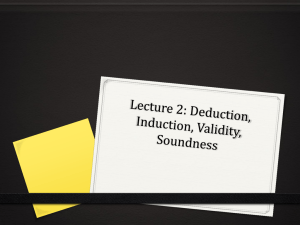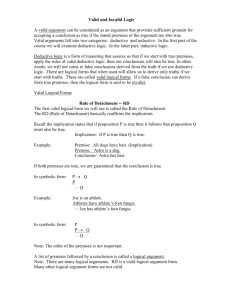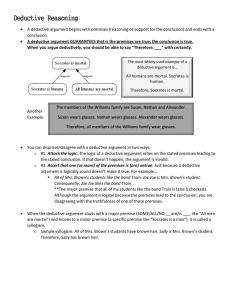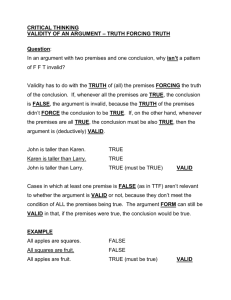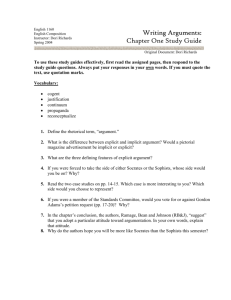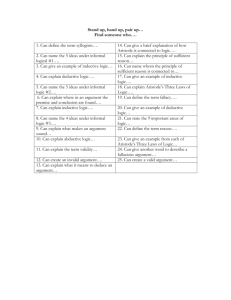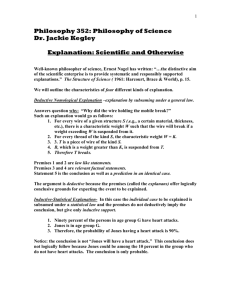Class #4 - 9/24/2014
advertisement
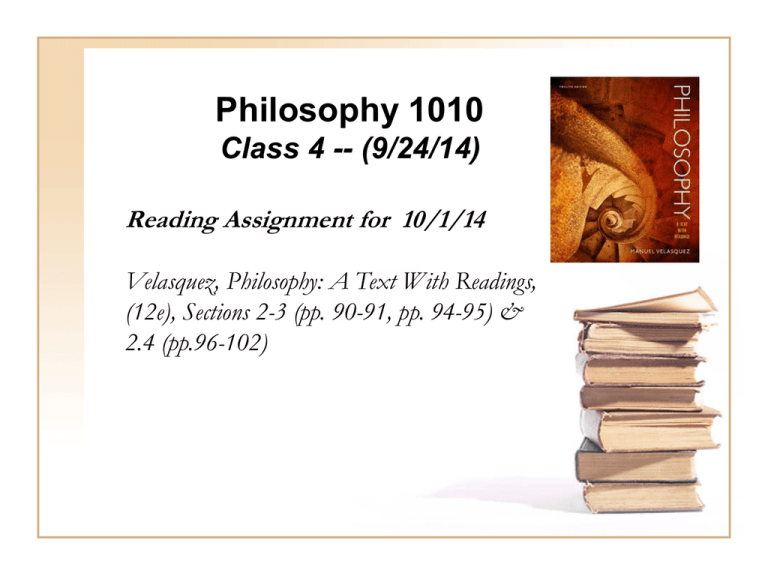
Philosophy 1010 Class 4 -- (9/24/14) Reading Assignment for 10/1/14 Velasquez, Philosophy: A Text With Readings, (12e), Sections 2-3 (pp. 90-91, pp. 94-95) & 2.4 (pp.96-102) Writing Assignment Worth 10 points in Participation Category. Review your answer to the question from the previous week of class. Evaluate your argument (and improve it) based on the principles of logic that we have discussed. Can you now propose a better argument? Be sure you state specifically what is your claim/conclusion? Does the question you asked still need to be clarified? What are your premises or “reasons to believe”? Is your argument deductive or inductive? If deductive, is it valid and sound? If inductive, is it strong? Philosophy Applied Watch any movie listed below. Write a 3 paragraph (200-250 word) mini-essay discussing one or two scenes in the movie and how the scene(s) illustrate(s) a philosophical view on the Nature of Man that is discussed in Chapter Two. Movie List: Schindler’s List (1993), River’s Edge (1986), Leaving Las Vegas (1995), Blade Runner (1982), Who is Julia? (1986), A.I.: Artificial Intelligence (2001), Momento (2000), Total Recall (1990), The Bourne Identity (2002), Bend It Like Beckham (2002), My Big Fat Greek Wedding (2002), The Long Walk Home (1990), Dark City (1998) Philosophy Applied: Schindler’s List Schindler’s List tells the true story of the German businessman Oskar Schindler who comes to Nazioccupied Poland in hopes of using the abundant slave labor force of Jews to manufacture goods for the German military to make himself a fortune. By the end of the film, he saves the lives of more than 1,100 Jews by sacrificing his personal fortune. While watching these film segments, consider views on human nature that you arereading about in chapter two of the textbook: e.g. Sigmund Freud, Thomas Hobbes, Moritz Schlick, Aristotle, Jean-Paul Sartre Plato & the Allegory of the Cave • Plato was a student of Socrates. To better understand what philosophy is, he describes the nature of philosophy in the Allegory of the Cave. • Plato compares the state of man’s ignorance to living at the bottom of an underground cave chained so that such men cannot move. All they see are shadows created by a fire behind them. • Through this symbolism, he then describes the act of philosophy which he likens to the prisoners being freed from their chains. • Plato is suggesting to us that this process is the “ascent of the mind into the domain of true knowledge.” Plato suggests that the aim of philosophy is freedom from unwarranted belief. The Allegory of the Cave Video The Matrix / The Allegory of the Cave The Matrix Trailer Video What Is Philosophy? Disk 1 from “The Examined Life” Video Series Ten Minute Break! Plato’s Dialogues & the Socratic Method • In Plato’s The Republic, Socrates questions Thrasymachus who states that justice is whatever is to the advantage of the strong, that “might makes right.” • Socrates asks what if the powerful pass laws that in error do not benefit themselves. Would not justice then be following laws that do not benefit the strong? Then justice would be in following laws that do not benefit them. • Thus, Socrates has pointed out to Thrasymachus that his commonly held view is quite likely inconsistent, or at least needs to be qualified and made clearer. Plato’s Dialogues & the Socratic Search for How to Live • Plato’s dialogues demonstrate that Socrates was not just trying to be “smart” but was in the profound pursuit of how one should live. • In The Apology, Socrates defends his way of life. He proclaims that his mission came from a divine commandment to seek wisdom. Thus, he questioned everyone he professed knowledge to find wisdom, only to find that the wisest man is he who knows he does not know. • Even in the face of death, Socrates proclaims he can act no differently. It is better to obey the gods than man. The unexamined life is not worth living. His pursuit of philosophy is following the instruction of the gods. Video Plato’s Dialogues & the Socratic Search for How to Live • In the Crito, Socrates is awaiting execution in his prison. Crito suggests that for the benefit of his friends and family, Socrates should escape. “It is the opinion of all of your friends, Socrates.” • Socrates replies that in order to act on reason alone, Socrates asks Crito what is right and wrong and we must not follow the “morality of the many” but follow what is truly right. • Socrates further argues that what is the right way to live consists in obeying the state in which we have contracted to live. Thus, we must obey the laws of the society in which we live, even when those laws and actions are unjust. Critical Thinking & Critical Reasoning The Fundamental Principle of Critical Thinking is The Nature of an Argument • Making a claim is stating a belief or opinion -- the conclusion • An argument is presented when you give a reason or reasons that the claim is true. -- the premise(s) • Thus, an argument consists of two parts, and one part (the premise or premises) is/are the reason(s) for thinking that the conclusion is true. What is a Factual Claim? • A claim is sometimes called an assertion, an opinion, a belief, a “view”, a thought, a conviction, or perhaps, an idea. • A claim must be expressed as a statement or a complete, declarative sentence. It cannot be a question. • In its clearest form, a claim asserts that something is true or false. That is, it asserts a fact. This kind of claim is known as a “factual claim” or a “descriptive claim.” What is a Normative Claim? • Value statements can also be claims though. In such claims, a fact is not asserted in the same sense that it was in factual claims. • For example, the claim “You should come to class” is not true or false (at least in the same way that the claim “P1100 class is held in Room 218” is). • Thus, some claims are “normative claims” or “prescriptive claims.” They express values and how one should act based on values. A value statement is a claim that asserts something is good or bad. Now, Critical Thinking is Absolutely Relevant to Both Sets of Claims • As we shall see in this class, it is necessary that we identify very clearly which kind of a claim we have before we can properly evaluate any argument for it! • Thus, please note we are taking a position against the subjectivist and saying that even moral judgments can be analyzed by the principles of critical thinking. Two Kinds of Good Arguments • 1) A good deductive argument is one in which if the premises are true, then the conclusion necessarily (I.e. has to be) true. • Such an argument is called “valid” and “proves” the conclusion. • For example – Julie lives in the United States because she lives in Nebraska. All men are mortal. Socrates is a man. ____ Socrates is mortal. • A sound argument is a valid, deductive argument in which the premises are in fact true. How Do Premises Support Conclusions? For a Deductive argument, premises prove a conclusion based on the logical form of the statement. Consider the argument: (P1) If it’s raining outside, the grass is wet. (P2) It’s raining outside. _________________________ (Conclusion) The grass is wet. In this case, the premises support the conclusion fully simply by what the premises say. It would be a contradiction to suggest that the conclusion is false but the premises are true. So what kind of an argument is this? A good God would not permit evil to exist. There is evil in the world. ____ Thus, a good God does not exist. Say G = A good God exists, E= There is no evil in the world. Is this argument of the form: If G E ~E _____ ~G If so, it is a valid deductive argument. Two Kinds of Good Arguments • A good inductive argument is one in which if the premises are true, then the conclusion is probably true, but not always. The truth of the premises do not guarantee the truth of the conclusion. • Such an argument is called “strong” and supports the conclusion. • For example: Dan lives in Nebraska and he loves football, so he is a Nebraska Cornhusker fan. If offered to me before class tonight, I would have made a bet with my wife that each of you would sit in the same seat in class that you did last week. If she would have taken the bet, would I have won more money than I would have lost? How Do Premises Support Conclusions? For an Inductive argument, premises support (never prove) a conclusion based on how good the premises provide evidence for the conclusion. Consider the argument: (P1) If it’s raining outside, the grass near the house gets wet when the wind is not blowing strongly from the North (which doesn’t often occur). (P2) It’s raining outside. _________________________ The grass near the house is wet. Note: It would not be a contradiction to suggest that the conclusion is false but the premises are true. 4 Steps to Evaluating an Argument 1. Be sure you understand the argument. What is the claim? What are the premises for the claim? 2. Determine if the argument is deductive or inductive and apply the appropriate test for validity or strong support. 3. Identify and weed out any logical fallacies, rhetoric, subjectivity, or irrelevancies. Clarify any vagueness or ambiguity. 4. Examine the truth of the premises. If the argument is inductive, evaluate the evidence.
